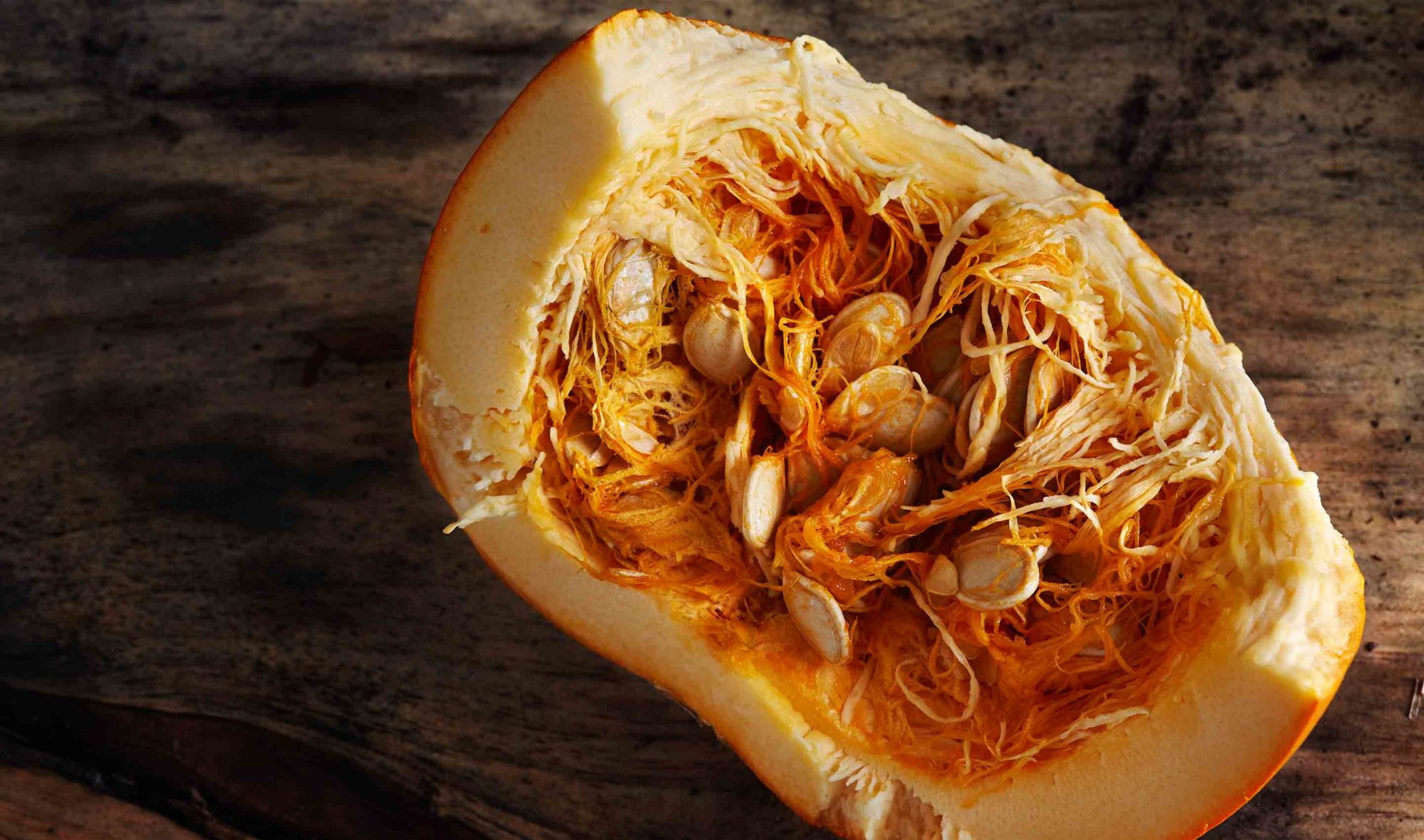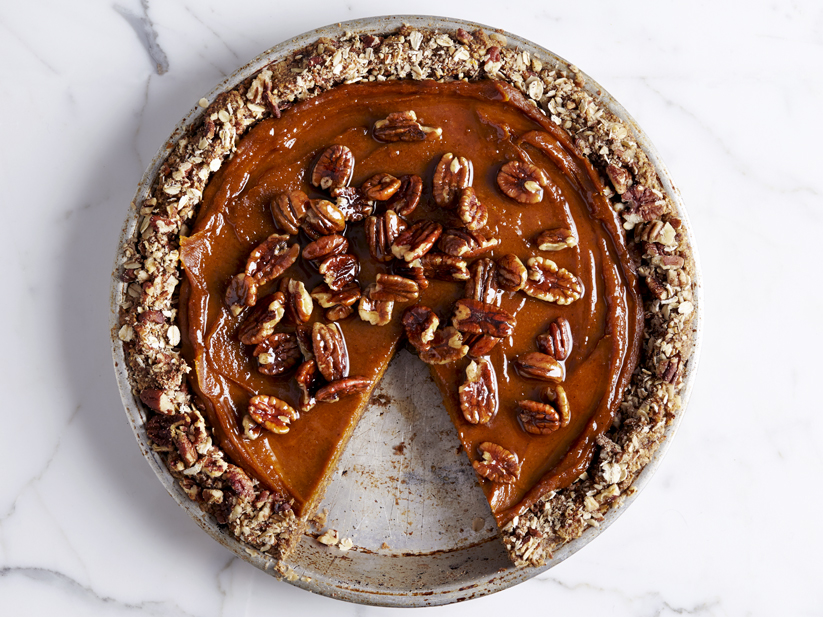
Join PN Level 2 for less than $9 USD/day! Affordable monthly payments now open.

A pumpkin is a large, round type of winter squash, which comes into season during fall. Most pumpkins are large, round and bright orange in color. But there are different varieties, which range in color, size and flavor. Some varieties, such as sugar pie pumpkins, are prized for their sweet, tender flesh and used mostly in baking. Pumpkin offers slow-digesting carbohydrates, some fiber, a healthy dose of beta-carotene, and a mix of other vitamins and minerals including vitamin C, E, potassium, and magnesium. Pumpkin is commonly found in a can: make sure to buy pure pumpkin puree with no added flavorings. Alternatively, you can cook a whole pumpkin and eat the cooked flesh. It’s great in baked goods, but also in soups, stews, curries, and even smoothies.
A pumpkin is a large, round type of winter squash, native to North America, which grows on a vine.
Inside its thick, smooth shell, a pumpkin contains seeds, stringy pulp, and pumpkin flesh. The seeds and flesh can be eaten, as can the flowers, which grow on the vine.
In the US and Canada, pumpkins are often used for decoration during Halloween, and baked into pies at Thanksgiving. However, many edible varieties of pumpkin exist and can be enjoyed in a multitude of preparations. Sometimes other types of winter squash are referred to as pumpkins.
Pumpkins are typically round with a yellow-orange shell and similarly colored flesh.
Pumpkins range in size and flavor; some varieties, such as sugar pie pumpkins, are small and prized for their sweet, tender flesh, which is ideal for baking.
Some varieties have a different color than the typical bright orange; for example, green or black pumpkins can be found. However, they are usually used for decorative rather than culinary purposes.
1 cup of mashed, cooked pumpkin (boiled and drained, without salt) contains approximately 49 calories, 1.8g of protein, 0.2g of fat, 12.0g of carbohydrates, 2.7g of fiber, and 5.1g of sugar.
Pumpkin packs in healthy amounts of vitamin K, A, C and E as well as potassium and magnesium. Pumpkin is also an excellent source of carotenoids (beta-carotene).
Canned pumpkin is a convenient and common way to purchase pumpkin. If purchasing canned, look for 100% pure pumpkin with no added ingredients. Choose cans that are not dented and check the expiry date before buying.
If seeking fresh pumpkin, you may consider going straight to the source: the farm, or alternatively, the farmer’s market. This is where you can get better acquainted with the varieties available and even ask the farmer for recommendations based on how you plan to cook the pumpkin.
When choosing a pumpkin, pick one that’s a smaller size: they tend to have tastier flesh. Make sure its stem is attached and the skin is unblemished — avoid pumpkins with any weepy or deeply bruised spots. Look for a dull finish (a shiny shell indicates it was picked too soon).
Store canned pumpkin as you would any canned product. Store any remaining canned pumpkin in an airtight container (not the can it came in) for up to five days. Alternatively, you can freeze canned pumpkin in an airtight container for up to three months.
Store a whole, fresh pumpkin in a cool, dark place — avoid anywhere humid or damp.
One of the easiest and most versatile ways to use pumpkin is to make pumpkin puree. The puree can then be used in sweet or savory preparations.
To make pumpkin puree, simply take a 1 lb pumpkin (such as a sugar pumpkin) and cut into quarters. Meanwhile, heat oven to 350F.
Rub pumpkin flesh with a drizzle of olive oil or coconut oil. Roast on a baking sheet lined with foil, flesh side up. Cook until flesh is soft and can be easily mashed with a fork.
When cooked, remove flesh from the pumpkin shell. Let cool slightly. Puree in a food processor until smooth.
Use in your preferred method — the possibilities are endless. For example: for breakfast, try mixing the pumpkin puree into yogurt and granola, adding it to pancake batter, or including it in a protein shake. For dinner, turn the pumpkin puree into a soup or stew with fresh ginger and nutmeg. Finally, pumpkin makes for delicious desserts: pumpkin tarts, pumpkin cheesecake, even pumpkin ice cream are all tasty ways to enjoy pumpkin.
Tip: Reserve your pumpkin seeds to turn them into a tasty, healthy snack. To prepare toasted pumpkin seeds, heat oven to 250F. Lay seeds out on a baking sheet to create a single flat layer of seeds. (Make sure they are not stacked in a pile or they won’t dry out properly.) Roast, stirring occasionally, for about 1 hour. When done, sprinkle with sea salt and any other spices you like, and enjoy!

This pumpkin pie is rich, creamy, and absolutely delicious. It's perfect for a special occasion and will surely have you and your guests wanting seconds.
Prep Time: 30 minutes Cook Time: 25 minutes Yield: 8-10 slices
Crust:
Put all ingredients into your blender or food processor and process until smooth. You may need to scrape the sides of your blender/food processor with a spoon a couple of times.
Scoop the batter into a 9-inch pie dish lightly greased with coconut oil. Sprinkle the top of the dough with oat flour (so that your fingers don’t stick to the crust) and press the crust down using your fingers. Press it down as evenly as possible pushing the dough up the sides of the pie plate.
Once the dough is well spread, bake it at 350 degrees Fahrenheit for 10-12 minutes or until it is no longer gooey to touch and the edges are golden brown.
Filling:
In a stovetop pot, mix together the pumpkin purée, cashew butter, pumpkin pie spice, and maple syrup (note that a larger pot works best – you want the base to have a large surface area).
Put the cornstarch in a mug or pyrex measuring cup and add cold water so that the cornstarch is just covered. Stir the cornstarch + water until the cornstarch is completely dissolved. Once dissolved, add the contents of the mug to your stovetop pot and mix well.
Put the pot on the stove and cook on med-high heat stirring continuously. Cook until filling starts to boil and you notice that it thickens (this usually happens about 2 minutes into boiling – you will also notice that the batter darkens a bit).
Once the batter has thickened, pour the contents of the pot over the piecrust smoothing it out as you go.
Note: There is a possibility that you will have a bit of extra pie filling. If this is the case, put the extra in a mug for pumpkin pie pudding later on.
If desired, garnish the pie with chopped pecans.
Let the pie cool on the counter and then transfer to the fridge. Let cool in the fridge for 4-6 hours before serving.
Store leftovers in the fridge.
Enjoy!
Precision Nutrition’s Encyclopedia of Food expands every single month as we highlight new foods and showcase beautiful food photography. If you’d like to stay up to date, simply click this link. From there, we’ll send you a FREE copy of our recipe book. We’ll also let you know when new and delicious foods are added to the site.
A pumpkin is a large, round type of winter squash, which comes into season during fall. Most pumpkins are large, round and bright orange in color. But there are different varieties, which range in color, size and flavor. Some varieties, such as sugar pie pumpkins, are prized for their sweet, tender flesh and used mostly in baking. Pumpkin offers slow-digesting carbohydrates, some fiber, a healthy dose of beta-carotene, and a mix of other vitamins and minerals including vitamin C, E, potassium, and magnesium. Pumpkin is commonly found in a can: make sure to buy pure pumpkin puree with no added flavorings. Alternatively, you can cook a whole pumpkin and eat the cooked flesh. It’s great in baked goods, but also in soups, stews, curries, and even smoothies.